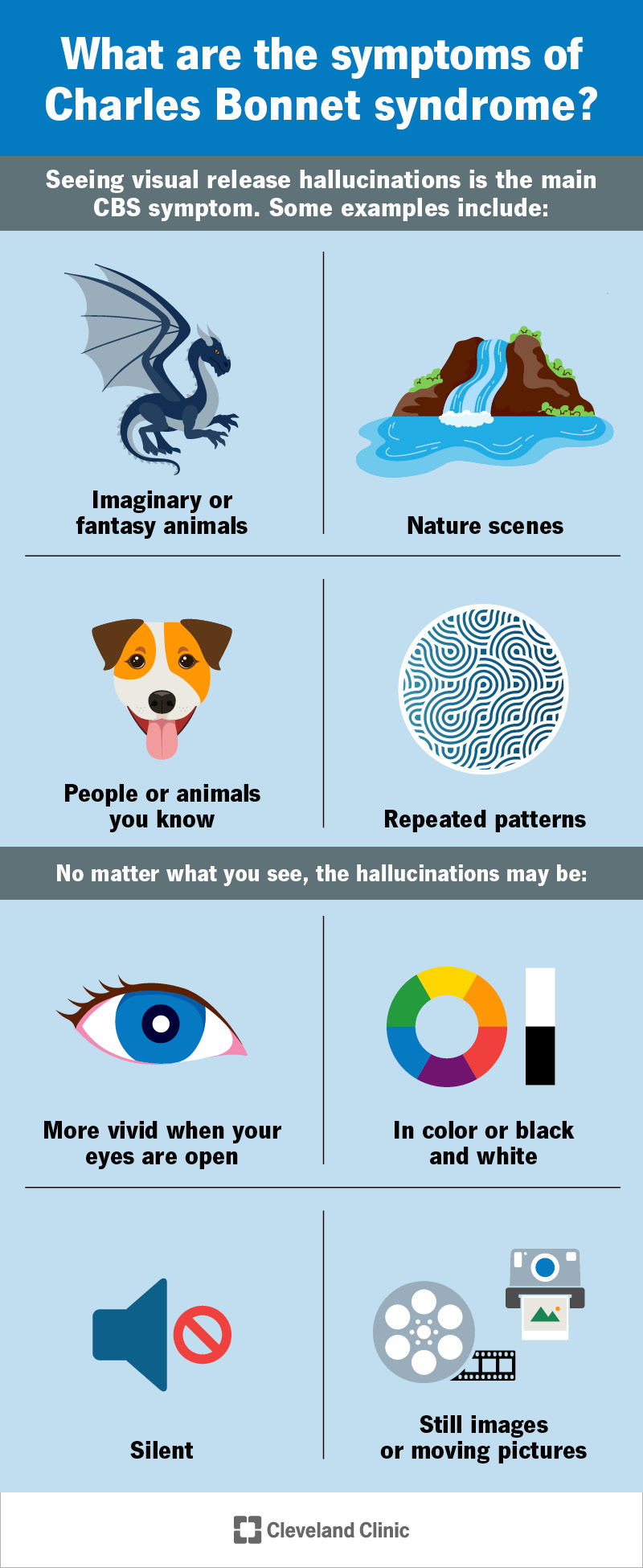Charles Bonnet Syndrome (visual release hallucinations) is when you see images or scenes that aren’t really there. Experts think it happens when your brain fills in gaps after something makes you lose some of your vision. There’s no cure, but your healthcare providers can help you adjust.
Advertisement
Cleveland Clinic is a non-profit academic medical center. Advertising on our site helps support our mission. We do not endorse non-Cleveland Clinic products or services. Policy

Charles Bonnet syndrome (CBS) is a condition that happens after you develop low vision. It makes you experience visual hallucinations. Healthcare providers also call it experiencing visual release hallucinations.
Advertisement
Cleveland Clinic is a non-profit academic medical center. Advertising on our site helps support our mission. We do not endorse non-Cleveland Clinic products or services. Policy
A hallucination is something you sense that seems real, but isn’t. Other people around you won’t see or experience it. If you have visual release hallucinations, your brain creates images that aren’t coming from your eyes. Visual release hallucinations aren’t related to psychiatric conditions.
Visual release hallucinations can be simple, like bright-colored patterns that show up over everything you see (unformed hallucinations). You might also see more complex images, like animals, buildings or people that don’t exist (formed hallucinations).
You’ll probably know the images aren’t real. Even if you can tell the hallucinations aren’t really there, they can still make you feel stressed or upset. The hallucinations shouldn’t speak to you or touch you.
Seeing visual release hallucinations is the main CBS symptom. Some examples include:
Advertisement
No matter what you see, the hallucinations may be:
You may see the same image or scene each time, but some people see something different each time they experience visual release hallucinations.
Losing some or all of your vision causes CBS. Experts think it happens when your brain tries to fill in the gaps after you experience vision loss.
Usually, your retina converts light into a visual signal for your brain. If you have low vision, your eyes can’t transmit as much information to your brain as it’s used to. When this happens, your brain may try completing the picture on its own. It may use your memories or make up new images.
Conditions related to developing Charles Bonnet syndrome include:
Remember, a psychiatric condition doesn’t cause these hallucinations.
Your risk of visual release hallucinations increases as you age. Up to half of people with low vision experience CBS at some point. But it usually happens after age 80.
You may be more likely to develop Charles Bonnet syndrome if you live alone or aren’t socially connected to many people. Spending a lot of time in the dark (indoors with natural light blocked out) may increase your risk, too.
A healthcare provider or eye care specialist will diagnose the hallucinations with a physical exam and a complete eye exam. They’ll ask about your medical history. Tell your provider when you first experienced a hallucination and if you know you have any eye conditions that reduce your vision.
Tell your provider if you’ve recently had eye surgery or started a new medication. Hallucinations can be a temporary side effect.
Your provider may give you a neurological exam or use imaging tests like an MRI or CT scan to rule out other issues that can cause hallucinations. Other conditions that can cause similar symptoms include:
There aren’t any treatments that can cure or prevent CBS. Fortunately, many people have fewer hallucinations (or stop having them completely) once their brain and eyes adjust to having reduced vision. This adjustment period usually takes a year or two.
Advertisement
Your healthcare provider can suggest ways to manage the hallucinations. These aren’t treatments to stop visual release hallucinations, but they can help your brain adjust. Your provider may recommend:
Advertisement
Visit a healthcare provider or eye care specialist as soon as you notice any changes in your eyes or vision. The sooner you get the underlying cause of CBS diagnosed, the better. Tell your provider if you’re having more (or more intense) visual release hallucinations. They may be able to suggest other ways to help manage them.
You might have to manage CBS for a while. It may disappear over time, but it can take a year or two to go away.
You may find it difficult to do some of your daily tasks or move around in places you don’t know well if you’re experiencing hallucinations. Don’t be afraid to ask for help from your healthcare provider or trusted loved ones. They can help you get any support and accommodations you need to do all your favorite activities.
Experiencing any kind of hallucination can be scary. It might be even more upsetting when you learn the condition that’s already affecting your vision causes it. But the good news is that most people adjust to Charles Bonnet syndrome and stop experiencing visual release hallucinations. There’s no cure, but your healthcare providers will suggest ways to help you adjust.
Talk to your loved ones and healthcare providers about what you’re seeing and feeling. The symptoms you’re experiencing are real, even if the images you see aren’t. You deserve to feel safe and supported no matter what.
Advertisement
Last reviewed on 07/09/2025.
Learn more about the Health Library and our editorial process.